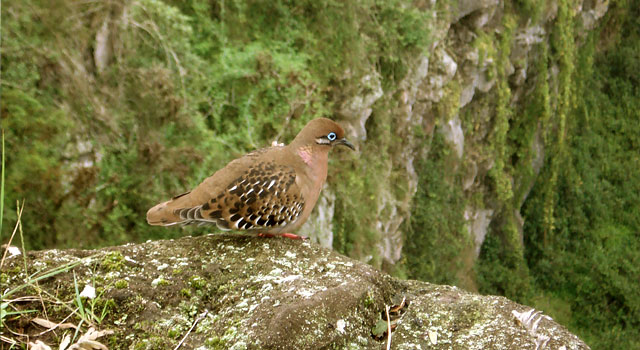Los Gemelos :: Santa Cruz Island

This area has received much use in recent years due to several trails created that lead to the two craters. Guides are asked to use only the National Park trail to avoid further erosion and deterioration of the area. In 1989 a circular path around the largest crater was opened, which passes through the interior of the Scalesia forest, an excellent place to observe land birds, especially the woodpecker finch and the vermillion flycatcher.
It is absolutely forbidden to eat fruit at this site; the seeds can fall by accident and could germinate. In recent years some plants have been introduced that are invading the Scalesia pedunculata forest rapidly.
Do not allow visitors to get too close to the edge of craters, the edges may collapse. Do not allow people to throw rocks or other objects inside the craters.
During rainy season, recommend that visitors bring with them a raincoat or a windbreaker. During the garúa season it can be foggy early in the morning but then clear and very pleasant weather later.
Galapagos Islands Tours Galapagos Islands Cruises Galapagos Islands Information
There are 7 genus of plants endemic to Galapagos, including Scalesia. Scalesia pedunculata, one of 14 species in the islands, is found using the niche of trees. These giant plants of the Compositaeson family, relatives of sunflowers and are the trees most characteristic of the upper parts of some of the islands. Other species of this genus are found in areas lower and drier, usually in the form of shrubs and not in forests. Scalesia pedunculata (which is found here) is well dispersed in the islands, found in Santa Cruz, San Cristóbal, Santiago and Floreana. Other species are more localized, one being Scalesia villosa, found only in certain areas of Floreana.
The phenomenon of "El Niño" destroyed a lot of well-developed and large trees in the forest of the Pit Craters; now the trees in the area are mostly young.
![]()
The vermillion flycatcher is the most outstanding terrestrial bird in the upper parts of most of the islands. The Pit Craters is perhaps the best place for observing them, since they occur in large numbers in the Scalesia forest. They are curious and usually fairly tame. They feed on insects they often trap with their peak in mid-flight. Their nesting season is from January to April; they put 3 eggs in a nest constructed of moss and lichen. The vermillion flycatcher inhabits many areas of North and South America.
The Pit Craters are, geologically speaking, seen as craters and its formation is not directly due to volcanic action. They were created as a result of the collapse or sinking of surface materials into cracks or manholes.
Another plant that draws attention at the Pit Craters is the Galapagos Guava or guayabillo tree, Psidium galapageium, which have a clean and smooth bark. Its branches are covered with epiphytes and brown liverworts, Bryopteris liebmanniana that many people confuse with moss.
![]()
Galapagos Islands Tours Galapagos Islands Cruises Galapagos Islands Information

